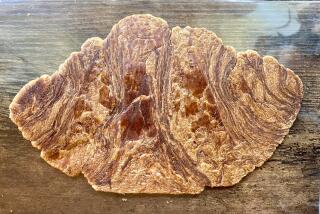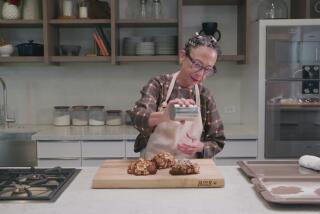Test Kitchen video tip: Checking your oven for accuracy

Times Test Kitchen director Noelle Carter shows how easy it is to check your oven for accuracy.
Every cook needs an accurate oven to get the job done right. In the Test Kithen, we routinely check our ovens for accuracy, looking for flattened gaskets and loose hinges, double-checking calibration and making sure our baking racks are in the center of each oven.
Here are some tips for determining, maintaining and making the most of your oven’s accuracy:
Checking for accuracy:
- Most oven problems can be traced to calibration. If this is off, your oven won’t work at the right temperature; a difference of as little as 25 degrees can make or break a fragile recipe such as custard. If you think the temperature gauge is inaccurate, test it against a little oven thermometer; these handy items are available at many supermarkets and most cooking supply stores. If your oven is off, you can often fix this yourself; many ovens can easily be recalibrated, but check the owner’s manual to be sure. Otherwise, call a service professional.
Maintaining accuracy:
- Always be gentle when opening and closing the door. Slamming the door will almost always throw off your oven’s calibration.
- Check the gasket around the door to make sure that it’s attached and properly fitted. A loose gasket will allow heat to escape.
- Make sure any vents are unobstructed.
Making the most of your oven:
- Unless the recipe states otherwise, place your items in the center of the oven, preferably on the center rack, where the heat is most consistent.
- If baking multiple racks of items, such as cookies, rotate the trays (top to bottom, front to back) for more even baking.
- Remember that various materials -- glass, metal (light and dark) and ceramic -- react differently to heat and will produce varying results.
- Avoid opening the oven door unless necessary. It may be tempting, but an open door allows heat to escape.
- See more at: https://latimesblogs.latimes.com/dailydish/2011/01/la-times-test-kitchen-tips-oven-accuracy.html#sthash.NpAt3sax.dpuf
Every cook needs an accurate oven to get the job done right. In the Test Kitchen, we routinely check our ovens for accuracy, looking for flattened gaskets and loose hinges, double-checking calibration and making sure our baking racks are in the center of each oven.
Here are some tips for determining, maintaining and making the most of your oven’s accuracy:
Checking for accuracy:
- Most oven problems can be traced to calibration. If this is off, your oven won’t work at the right temperature; a difference of as little as 25 degrees can make or break a fragile recipe such as custard. If you think the temperature gauge is inaccurate, test it against a little oven thermometer; these handy items are available at many supermarkets and most cooking supply stores. If your oven is off, you can often fix this yourself; many ovens can easily be recalibrated, but check the owner’s manual to be sure. Otherwise, call a service professional.
Maintaining accuracy:
- Always be gentle when opening and closing the door. Slamming the door will almost always throw off your oven’s calibration.
- Check the gasket around the door to make sure that it’s attached and properly fitted. A loose gasket will allow heat to escape.
- Make sure any vents are unobstructed.
Making the most of your oven:
- Unless the recipe states otherwise, place your items in the center of the oven, preferably on the center rack, where the heat is most consistent.
- If baking multiple racks of items, such as cookies, rotate the trays (top to bottom, front to back) for more even baking.
- Remember that various materials -- glass, metal (light and dark) and ceramic -- react differently to heat and will produce varying results.
- Avoid opening the oven door unless necessary. It may be tempting, but an open door allows heat to escape.
- See more at: https://latimesblogs.latimes.com/dailydish/2011/01/la-times-test-kitchen-tips-oven-accuracy.html#sthash.NpAt3sax.dpuf
Every cook needs an accurate oven to get the job done right. In the Test Kithen, we routinely check our ovens for accuracy, looking for flattened gaskets and loose hinges, double-checking calibration and making sure our baking racks are in the center of each oven.
Here are some tips for determining, maintaining and making the most of your oven’s accuracy:
Checking for accuracy:
- Most oven problems can be traced to calibration. If this is off, your oven won’t work at the right temperature; a difference of as little as 25 degrees can make or break a fragile recipe such as custard. If you think the temperature gauge is inaccurate, test it against a little oven thermometer; these handy items are available at many supermarkets and most cooking supply stores. If your oven is off, you can often fix this yourself; many ovens can easily be recalibrated, but check the owner’s manual to be sure. Otherwise, call a service professional.
Maintaining accuracy:
- Always be gentle when opening and closing the door. Slamming the door will almost always throw off your oven’s calibration.
- Check the gasket around the door to make sure that it’s attached and properly fitted. A loose gasket will allow heat to escape.
- Make sure any vents are unobstructed.
Making the most of your oven:
- Unless the recipe states otherwise, place your items in the center of the oven, preferably on the center rack, where the heat is most consistent.
- If baking multiple racks of items, such as cookies, rotate the trays (top to bottom, front to back) for more even baking.
- Remember that various materials -- glass, metal (light and dark) and ceramic -- react differently to heat and will produce varying results.
- Avoid opening the oven door unless necessary. It may be tempting, but an open door allows heat to escape.
- See more at: https://latimesblogs.latimes.com/dailydish/2011/01/la-times-test-kitchen-tips-oven-accuracy.html#sthash.NpAt3sax.dpufEvery cook needs an accurate oven to get the job done right. In the Test Kithen, we routinely check our ovens for accuracy, looking for flattened gaskets and loose hinges, double-checking calibration and making sure our baking racks are in the center of each oven.
Every cook needs an accurate oven to get the job done right. In the L.A. Times Test Kitchen, we routinely check our ovens for accuracy, looking for flattened gaskets and loose hinges, double-checking calibration and making sure our baking racks are in the center of each oven.
Here are some tips for determining, maintaining and making the most of your oven’s accuracy:
Checking for accuracy:
- Most oven problems can be traced to calibration. If this is off your oven won’t work at the right temperature; a difference of as little as 25 degrees can make or break a fragile recipe such as custard. If you think the temperature gauge is inaccurate, test it against a little oven thermometer; these handy items are available at many supermarkets and most cooking supply stores. If your oven is off, you can often fix this yourself; many ovens can easily be recalibrated, but check the owner’s manual to be sure. Otherwise, call a service professional.
VIDEO: TEST KITCHEN TIPS FROM THE L.A. TIMES
Maintaining accuracy:
- Always be gentle when opening and closing the door. Slamming the door will almost always throw off your oven’s calibration.
- Check the gasket around the door to make sure that it’s attached and properly fitted. A loose gasket will allow heat to escape.
- Make sure any vents are unobstructed.
RECIPES: 99 easy dinner ideas in about an hour or less
Making the most of your oven:
- Unless the recipe states otherwise, place your items in the center of the oven, preferably on the center rack, where the heat is most consistent.
- If baking multiple racks of items, such as cookies, rotate the trays (top to bottom, front to back) for more even baking.
- Remember that various materials -- glass, metal (light and dark) and ceramic -- react differently to heat and will produce varying results.
- Avoid opening the oven door unless necessary. It may be tempting, but an open door allows heat to escape.
If you have any gadgets, kitchen tips or questions you’d like me to explore, leave a comment below or shoot me an email at noelle.carter@latimes.com.
ALSO:
Go behind the scenes at the Test Kitchen
134 recipes for your favorite restaurant dishes
Browse hundreds of recipes from the L.A. Times Test Kitchen
More to Read
Eat your way across L.A.
Get our weekly Tasting Notes newsletter for reviews, news and more.
You may occasionally receive promotional content from the Los Angeles Times.







